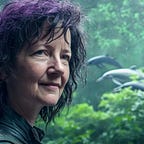Technology, a Different View
Two graphs changed my way of thinking about technology
Today I want to tell you about two graphs that changed my way of thinking about technology. After working for 25+ years in business management and often for high-tech companies, I developed my own way to be an alpha between the betas.
I love science and technology, but I also realize that we need to use technology with a purpose. The graphs that I am talking about made me curious about what we humans can achieve if we think different.
If we approach technology by learning from nature instead of staying on our current path of energy-addicted, material-intensive, waste-generating technologies.
Inspired by a book
Let me first introduce the graphs to you. The graphs and their explanation come from the book ‘De natuur als uitvinder’ (Nature as Inventor) written by Ylva Poelman, a renowned physics and astronomy scientist, founder of the bionica centre in The Netherlands.
Sorry for my English-reading audience: the book has been published in Dutch. But for my Dutch audience: Ylva is an inspiring writer about technology and nature. She also writes weekly columns for newspaper Trouw, that can be found online as well.
